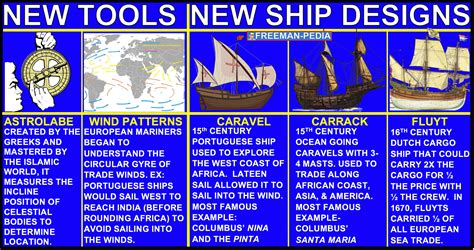The period between 1450 and 1750 witnessed a surge in maritime innovation, driven by the desire for exploration, trade, and warfare. These innovations transformed ship design, construction, and navigation, enabling sailors to venture further and more efficiently than ever before.

Lateen Sails and the Carrack
The lateen sail, a triangular sail with a spar running along its leading edge, became widespread during this period. Lateen sails allowed ships to sail closer to the wind, improving maneuverability and speed. The carrack, a large, ocean-going ship, adopted the lateen sail, making it a dominant vessel for exploration and trade.
Stern Rudders and the Astrolabe
In the 15th century, the stern rudder, a hinged rudder mounted at the ship’s stern, replaced the steering oar. This innovation provided greater control and stability, allowing ships to navigate more precisely. Additionally, the development of the astrolabe, an instrument used to measure the altitude of celestial bodies, enabled sailors to determine their latitude, greatly improving navigation.
Iron Cladding and the Frigate
In the 16th century, iron was increasingly used to reinforce ship hulls, providing protection from enemy fire. This led to the development of ironclads, warships with iron plating covering the entire hull or parts of it. The frigate, a fast, maneuverable warship with a long, narrow hull, emerged in the 17th century. Frigates were armed with cannons and used for scouting, escort, and combat.
Advances in Shipbuilding Techniques
Shipbuilding techniques also underwent significant improvements during this period. The use of frames and planking, rather than solid logs, lightened ship construction while increasing strength. The invention of the shipwright’s rule, a specialized measuring tool, allowed for more precise and efficient ship design.
Navigation and Cartography
The development of more accurate navigation instruments and charts led to improved seafaring. The compass, first introduced in China, became widely used in Europe, providing constant direction. Sailors also relied on celestial navigation, using the stars and sun to determine their position.
The 16th century witnessed the emergence of scientific cartography, with the production of detailed maps based on empirical observations. These maps, such as the portolan chart, depicted coastlines, islands, and navigation hazards, aiding in safer voyages.
Motivations for Ship Innovation
The motivations for ship innovation were vielfältig:
- Exploration: Discoveries of new lands and trade routes fueled the need for ships that could travel long distances and withstand adverse conditions.
- Trade: The expansion of global trade demanded vessels capable of transporting large quantities of goods efficiently.
- Warfare: Naval conflicts drove the development of faster, more powerful warships.
Benefits of Ship Innovation
Ship innovations had numerous benefits:
- Increased Range and Speed: Lateen sails and improved ship design allowed ships to sail further and faster.
- Improved Maneuverability and Control: Stern rudders and astrolabes gave sailors greater control over the ship’s movement and position.
- Enhanced Protection: Iron cladding provided protection from enemy fire, increasing ship survivability.
- Safer Navigation: Accurate navigation instruments and charts reduced the risk of shipwrecks and collisions.
- Efficient Trade: Larger ships and improved navigation enabled the transport of goods over longer distances, boosting trade.
Conclusion
The period between 1450 and 1750 was a period of extraordinary innovation in ship design and construction. These innovations transformed maritime exploration, trade, and warfare, shaping the course of human history. The advancements made during this time laid the foundation for the modern shipbuilding industry and continue to influence ship design and navigation today.
Tables
| Innovation | Period | Impact |
|---|---|---|
| Lateen Sails | 15th Century | Improved maneuverability and speed |
| Stern Rudder | 15th Century | Increased control and stability |
| Iron Cladding | 16th Century | Enhanced protection from enemy fire |
| Astrolabe | 15th Century | Improved navigation and latitude determination |
